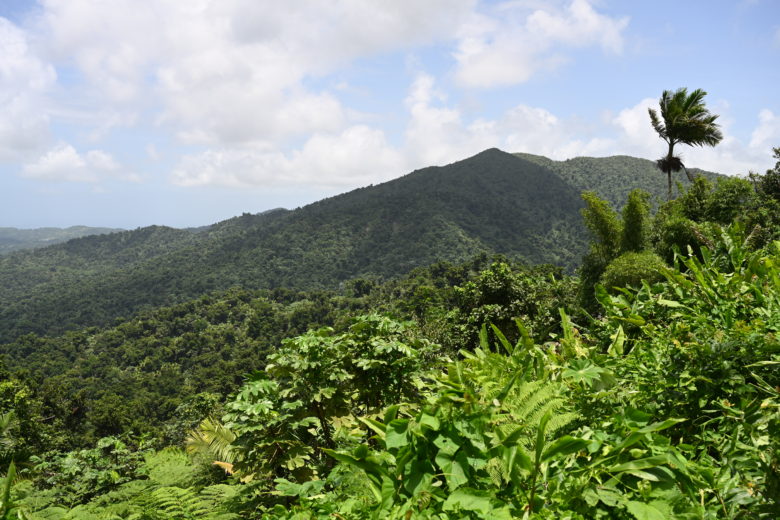Prologue
There are many ways to record a journey — by time, place, or themes, to name a few. For this trip, a free flow with little expectations and lots of meanderings, I decided to jot down things as it goes. A live journal, written at the end of each day when my body sinks from all the adventure and my mind from all the rum.
And where should I begin: this morning, I traversed the city to Newark airport through a nascent baby blue sky, sustaining myself on one and half hours of sleep yet slapped sober by the bold wind, surviving on a little insomniac drunkenness that breaks the cocoon and takes me out—
Somewhere.
Anywhere.
Elsewhere.
***
“Elsewhere is a negative mirror. The traveler recognizes the little that is theirs, discovering the much they have not had and will never have.”
— Italo Calvino, Invisible Cities
Everywhere is nowhere just like all black equals all white. But elsewhere is all but here—almost an oxymoron that centralizes the “here.” So on this trip let me redefine “here” with the hope that not only here is everywhere, but everywhere is here. Is it possible to find a tiny piece of ourselves in everything, and a bit of everything as our own?
Elsewhere as a kaleidoscope.
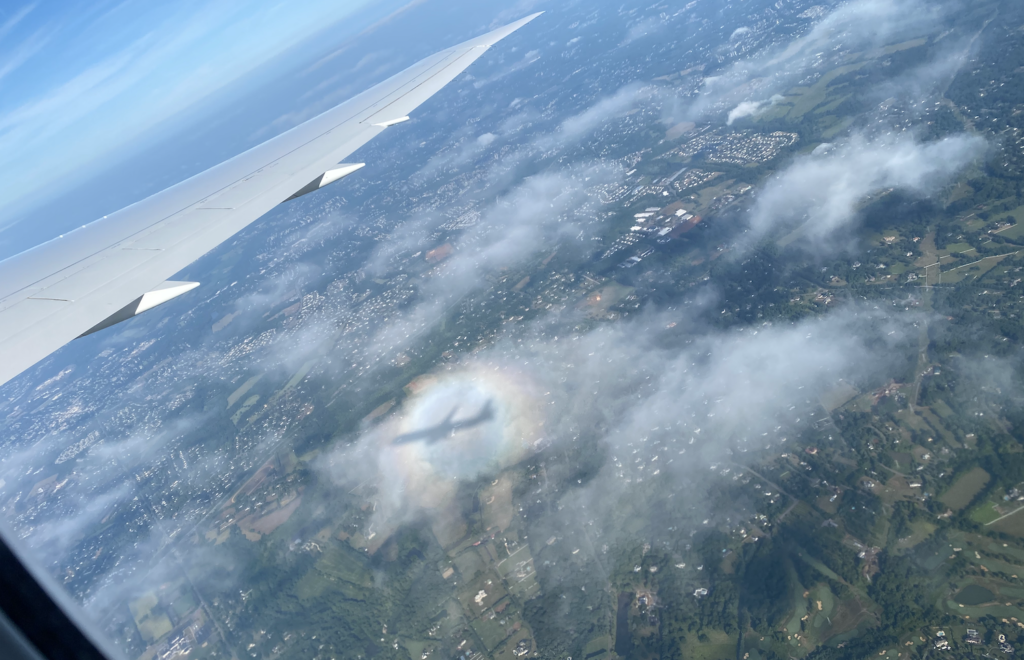
Day 1, 8/2, San Juan — A fort that devours
Hidden on the second level of Castillo San Felipe del Morro is its very inception: the original tower built in 1539, the oldest part of the fortification — or so says the sign. The circular tower cradles four cannons overlooking the channel mouth with three gunports. With increasing threats from other European colonial forces in the 17th century, Spain fortified El Morro and eventually, the massive fortress engulfed its older self.
The walls, hundreds of years old, felt like skin to me. The skin of the citadel, living and breathing and decaying at its own pace. The brown age spots on discolored stones, sharp wrinkles in mortar cracks. Carvings both ancient and modern, disfiguring cuts. Fragments of a shell lodged overhead, scars from the U.S. bombardment of San Juan in 1898.
How many tales tell of ghosts in a fort? But may the fort itself be the biggest ghost of all? A fort that both houses and devours, split in its desires. Garita del Diablo (“Devil’s Sentry Box”) at El Morro’s sister fort, Castillo San Cristóbal, supposedly once devours a Spanish soldier named Sanchez, who vanished with only his rifle and uniform scattered on the ground.
Walking inside the three 18th-century tunnels in San Cristóbal feels like moving through its intestines, perhaps not unlike how Pinocchio makes his way inside the giant sperm whale. The tunnels both protected defenders and buried intruders — but not everything vanishes. Inside a peculiar cave are elaborate sketches of galleons on the wall, attributed to a Spanish captain awaiting execution for mutiny. These drawings now stand defiantly, a testimony of humanity and brutality at once.
So it seems like every historical site asks tourists to reimagine the past. But where does the past reside? A photo book called “San Juan: Entonces y Ahora” always has a black & white picture on the left page and a colored one on the right. A monument to the defenders of San Juan during the 1625 Dutch attack now stands by a kite playground. The first proposes linear progression, the second superimposition. Both conceive the “past” as a giant blob of history replaced by the present. But the past only deceptively poses its own death: it trickles through time, the most gluttonous of all tenses, the strongest fort for defense.
“The pure present is an ungraspable advance of the past devouring the future. In truth, all sensation is already memory.”
—Henri Bergson
May the sea wash it all away one day — or so we wish.
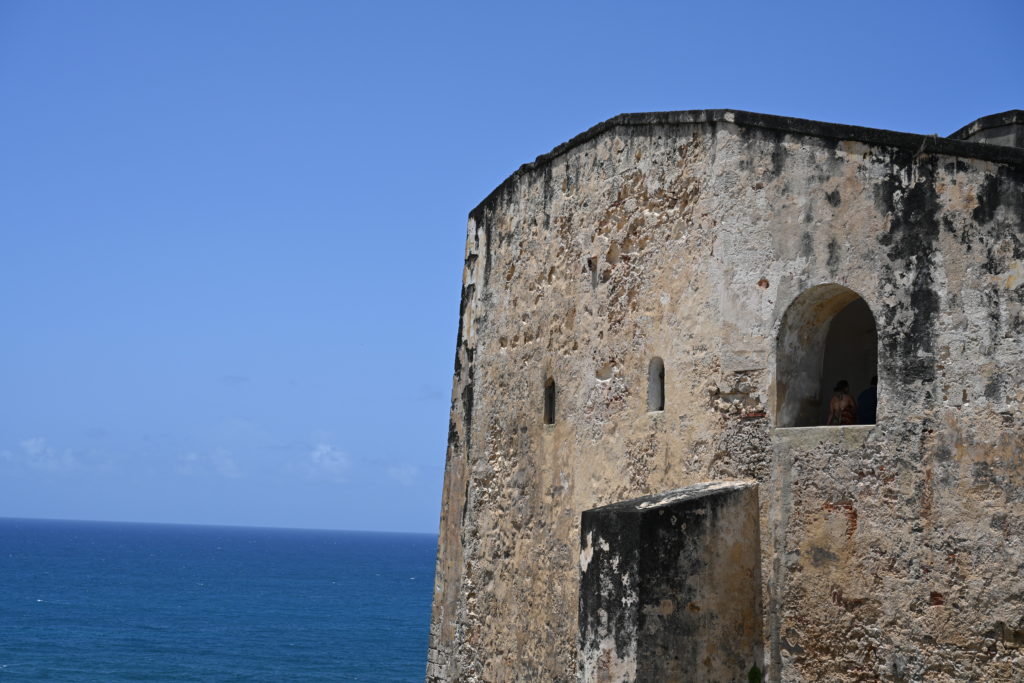
***
I left Old San Juan and checked in at the hostel, a two-floor white house with a weedy garden and three incredible dogs. Nobody was in the kitchen and my only roommate — a man, of course — was sleeping in our six-bed dorm. So I headed out to a local bar by myself.
It got dark soon but I walked on, following the salsa notes tripping in the wind. I approached the bar, the band, and its boisterous crowd, with middle-aged and senior couples dancing on the sidewalk. Sitting at a corner table with some chill local elders, I tried my best to blend in without arousing too much suspicion. An old lady with purple stockings, probably the bar’s hostess, stuck a cigarette into her mouth with such gravitas. I immediately lit my own.
I finished my frozen sangria and wings and walked back to the hostel along the dark streets. Once I got back, a group of young travelers — several of them solo — gathered in the kitchen, drank and laughed. As I stepped in they all turned and said hi. Then a guy poured me a shot of whiskey that was really two shots. I downed it with a few other guys. A girl who just graduated from college told me most of them had been staying and partying here for weeks.
I chatted while secretly wondering to myself: should my night end now, or should it just begin?
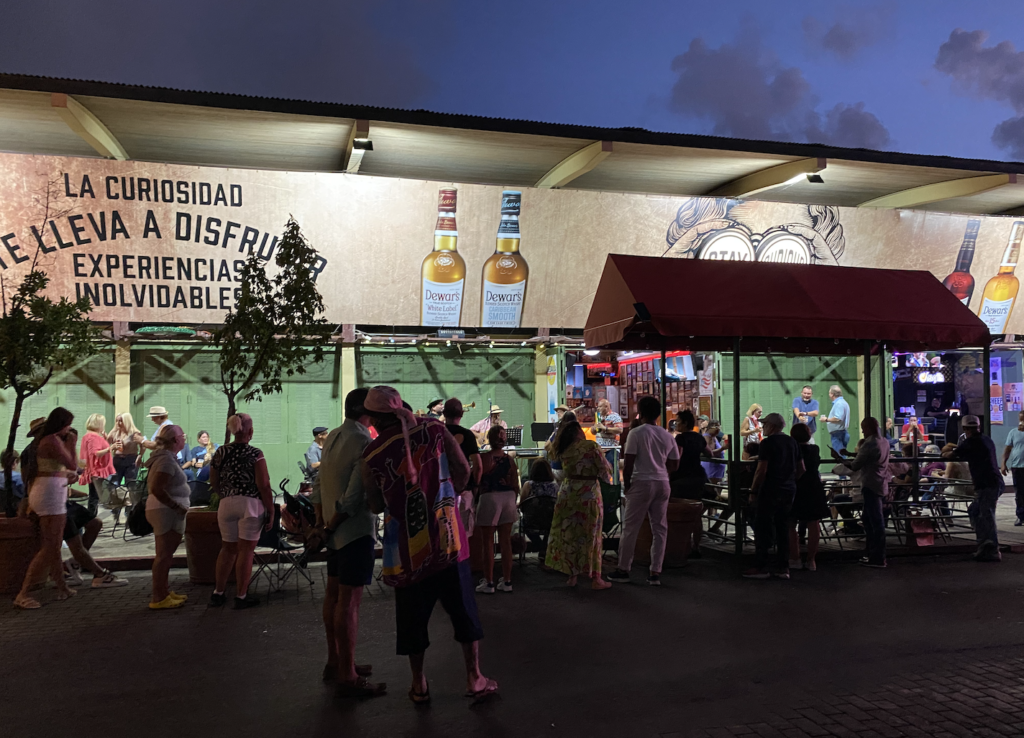
Day 2, 8/3, San Juan — Faces of “island time”
“Island time: The time vacuum created by the ocean’s presence. Similar to stoner’s time, everything moves nice and slow. This carefree aura even has the ability to travel with islanders and can engulf you in their presence.”
— Urban Dictionary
I ran into T on the stairs as I was about to go out in the morning. He wears a new white Ralph Lauren golf vest today — I thought he was the type who never changes. He’s the spirit of this hostel, always hanging around and gathering people for parties.
He asked me if I was by myself.
“Yes.”
“I would go with you if you want company. But if you don’t that’s fine too,” he said as if he didn’t really give a shit. He probably didn’t.
“Oh. I don’t mind having company at all,” I mumbled through this convoluted full sentence in an elevated pitch — signs that I really wanted to say no thanks but didn’t know how.
Eventually, we planned on hitting one of the local beaches in San Juan late afternoon. I wandered around in the morning and ate fish for lunch. I planned to check out a bunch of spots but none of those seemed very satisfying. So T and I met up back in the hostel kitchen.
“Okay. You ready? You mind if I hit the bomb first?”
“Oh. Sure.”
He led me to the smoking table near the garden, pointed to a blue Jack Daniels bottle connected with a mouthpiece.
“Self-made. My friend worked for the hostel and left it to me when he left.”
“Whaaaaat,” I wearily raised my eyebrows and feigned excitement in a quite stupid way. My heart sometimes just feels too old to get excited over a Jack Daniels bomb.
“You wanna smoke?”
Well, I thought getting high might help me socialize and get excited.
He lit it as I inhaled, waiting for the vapor to fill the bottle. Then a big hit. Meanwhile, I asked about him. How long he has stayed here, what he does back home, that kind of stuff.
“I don’t really go back to Miami all that much. I’ve stayed here for two months now. Might visit my grandma in Miami for three days. Then I’m going to Spain for a month. Then I plan to hike through South America for three months.”
“Oh,” I raised my eyebrows again, this time truly amazed.
“Yeah, it’s definitely a vibe,” that’s his fucking line. He hit the bomb again.
I had so many questions about him, his lifestyle, but didn’t dare ask. I smoked more and coughed.
“I guess you don’t smoke enough.”
He stood up to call a Uber, then a crazy gust of wind blew all the brown leaves on the tent down to our faces.
“Man it’s gonna rain,” he jumped to a corner.
So we decided to not go to el escarmbrón after all. He told me his dinner plans. I told him I would let him know, slowly inching back to my room, back to my quiet solitary shell, perhaps more relieved than disappointed.
Then my roommate M walked out. A tall man from Irvine working on an archive project for the army here. A contractor. At night he snores as if he’s really struggling to breathe and cries out constantly in sleep. I barely closed my eyes for the past two nights, feeling the pain for both myself and him.
“Dude,” he likes to call me dude. “What are you gonna do now?”
“I’ll go find a book,” I squeezed a smile just as lame as my words.
Then I slipped back to our room, catching a glance of T and M now smoking together under the tent.
I tried. But as soon as the high kicked in, I threw my book aside and hid myself under the white sheet, completely stoned. I tried to find the key to my locker but completely forgot where I put it twenty minutes ago. I looked at the watch, just shy of three. Then I felt myself plummet into a hole on the ground, covered with decaying leaves.
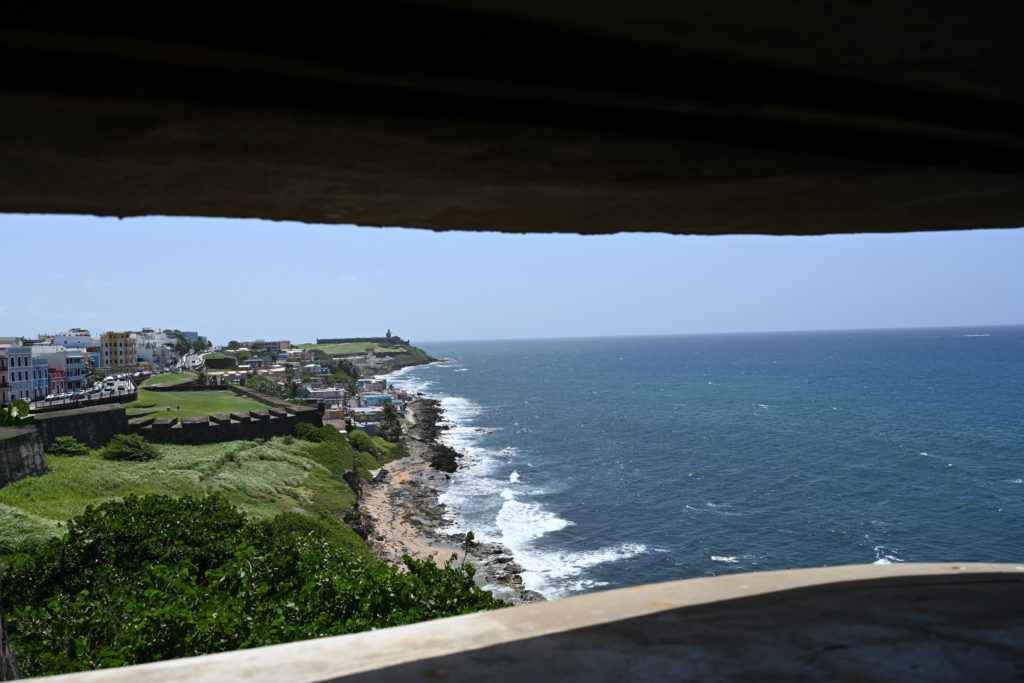
***
Everybody keeps reminding me, through words or actions, that we’re living on island time. The travelers more self-conscious than the locals sometimes.
People seem to consider it an antithesis of the 24/7 time. Jonathan Crary elucidates the latter in his fascinating book, 24/7: Late Capitalism and the Ends of Sleep: “it is a generalized inscription of human life into duration without breaks, defined by a principle of continuous functioning. It is a time that no longer passes, beyond clock time.” It is a time within which sleep has no necessity, where fantasies of “progress” are abandoned in favor of static redundancy. It renders plausible, if not normal, the idea of working without pause, without limits. Running in place.
The myth of island time, on the other hand, proposes pauses and slowness, a carefree aura by the sea. Taking the time to stare, to float, to chatter, to breathe. A late start is always fine, waiting is the norm of fun. Time becomes malleable, a fruit-flavored bubble gum. Yet it doesn’t mean an easy or lazy life — the locals work hard to accommodate the tourists, while the tourists work hard to enjoy themselves. It is more an attitude than a condition.
With the 24/7 mode deeply ingrained in my body, I’m always searching for things to do, trying to gain experiences. This so-called “island time” tortures me a little, exposing my impatience and sometimes excessive expectation toward others. And after smoking my whole afternoon off, I tagged it as a lesson and swore to not do it again — not in the near future, at least.
Time is subjective, personal, and felt; yet temporality is constructed, collective, and instructed. Island time as a temporality seems just as artificial as any other mode of time. On the surface level, it allows for the soul to replenish itself from work and stress. But defined against the backdrop of a 24/7 universe, it plays into the sleepless circle, a commodity promising temporary relief as long as one doubles up the work after. As I shall?
Later, later.
Day 3, 8/4, Fajardo —Wu Wei: “Non-doing”
(As I neglected to reserve a ticket, I had to postpone my hiking trip to El Yunque rainforest. Instead, I booked a tour that claimed to be “REAL hiking” in the forest but was really playing with some small waterfalls. And I hate tours. I abhor petty rules and generally like to stay away from people who are overwhelmingly cheerful in the group. As the lady nicely pointed a finger at me, told me to not go anywhere while waiting for the waterslide crew to come back, and waited for me to nod, I thanked her and told her I was leaving.
My two-hour sleep last night left me with low energy in comparison to the man who Tarzan-istically swung into the swimming hole. I sauntered away on the muddy trail like one of those long soft waves in the sea.)
An hour later I found myself walking along the beach of a seaside trail in Fajardo. The tides are rising, so I trod in the water and sand with my hiking shoes. Fifty feet into the trail I became the only one here. A long, quiet white shoreline stretching on into the clouds.
The trail leads up to a promontory that overlooks the bay. A black-and-white pelican rests on the bottom, still as the rocks underneath against the restless wind and crashing waves. Without a single human being in sight, I took off all my clothes and changed into a swimsuit, startled when my hat got blown away, tumbling on the green sea grape leaves.
As I sat on the rocks and spit out sand from my mouth, words and imagery from Abe’s The Woman in the Dunes drifted into my mind. “I rather think the world is like sand. The fundamental nature of sand is very difficult to grasp when you think of it in its stationary state,” he writes. “Sand not only flows, but this very flow is the sand.”
And what is not a flow? Every Chinese knows the concept of “无为” (Wu Wei), or non-doing, from Taoism, yet few can say what it truly means. I can’t either — but it doesn’t matter, as the Tao lies in the undescribable and the unspoken. Wu Wei proposes a flow state in which instead of doing an act, one becomes it naturally. One navigates and lives to the flow of the universe, whatever that means. But it’s true — this is one of the days where I feel something of this flow, letting myself be carried by it, dissolving the rigidity of plans and expectations.
“天下之至柔,驰骋天下之至坚。无有入无间,吾是以知无为之有益。不言之教,无为之益,天下希及之。”
— 《道德经》,43章
“That which offers no resistance, overcomes the hardest substances. That which offers no resistance can enter where there is no space. Few in the world can comprehend the teachings without words, or understand the value of non-doing.”
— Lao Tzu, Tao Te Ching, Chapter 43
On my way back, I floated in the ocean, moving with the cloud, imitating the shadow of a swallow-tailed kite soaring through the summer sky. The pelican flew past me again, like a dream, a vision, a metaphor, or does time simply repeat itself by flowing in a circle?
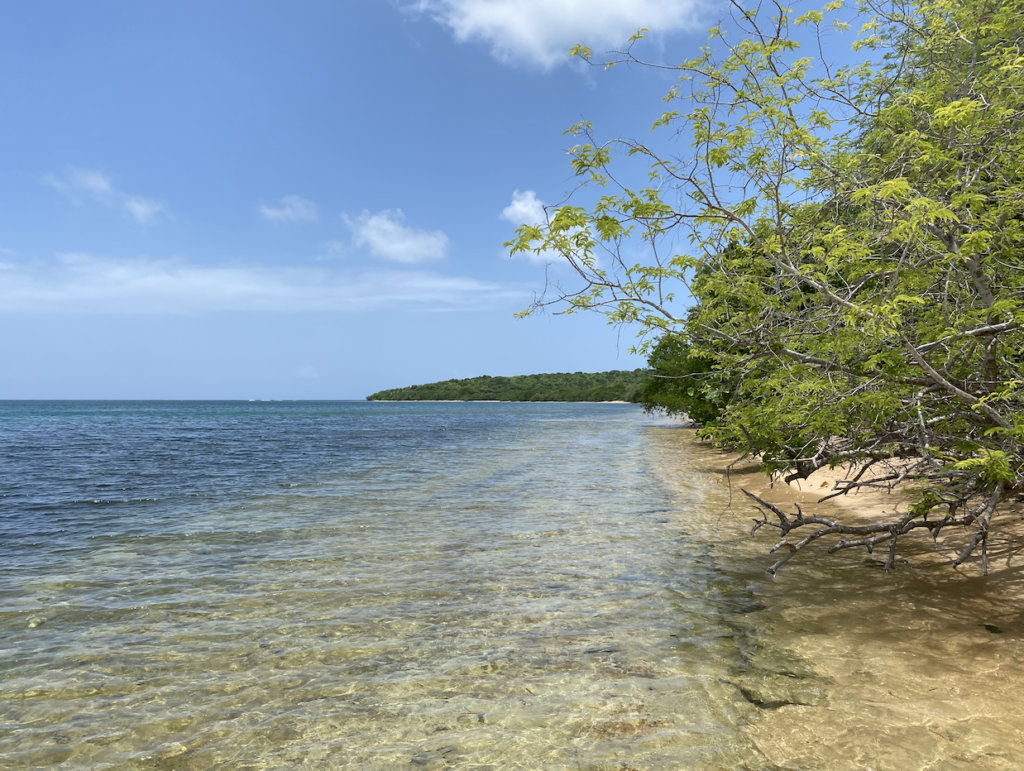
Day 4-6, 8/5-8/7, Vieques — A man who wanders
I hopped on one of those two-dollar ferries from Ceiba to Vieques, an island off Puerto Rico’s eastern coast. It was a 45-minute ride, calm waves and scorching sun. Then the driver from our car rental company picked a few of us up, blasting “Tití Me Preguntó” by Bad Bunny, the popular Puerto Rican rapper. During the climax, he tapped on the brake to make the whole van wiggle with the full dembow beat. He saw me taking a video through the rearview mirror and winked.
I drove across the island to the small southside town, Esperanza — a loose web of narrow roads lined with gaily painted stucco houses. They attest to how Vieques residents fought for recovery from the disastrous Hurricane Maria in September 2017, which hurled roofs, boats and cars, smashed windows and stripped trees.
There was no water for weeks, and for much longer no electricity. And today beneath the brilliant decorations and upbeat Caribbean ballads there must lay many unspoken struggles and painful memories. But how much could a traveler tell? We stay and leave, never quite understanding what history meant for a place. I drove on.
As soon as I arrived at my room in a blue house, I changed into bikinis and ran to a small trail behind the parking lot, following the sound of waves. The thorns of some acacia pricked my bare skin, but I didn’t mind. The enchantment of the sea was so complete.
The beach was empty. I held its saline air to my heart, excited by this secret discovery. The shore was rugged with rocks and seaweed, which was probably the reason why no one swam here. I opened my arms and walked in the ceaseless tides, bare soles against crude rocks, the strong wind driving me forward.
I turned around and suddenly three wild-looking horses pranced along me, two brown and one white. They stopped thirty feet away and turned into the bushes, but one of the brown horses stepped out and watched me. I slid past them — only then did they return to the hidden pond behind trees, disappearing just as soon as they came. Would I be surprised if Hippocampus suddenly rose from the ocean, carrying Poseidon on its back?
But it soon turned out the horses were not the only ones here. As I threw myself into the air with a swing on the coconut tree, a young white man with disheveled hair and a long brown beard walked toward me, retracing my footsteps. I tried to focus on the surreal seascape, but it was no longer possible. It felt like another human being landing on this desert island.
I glanced at his gaunt figure from time to time, calculating his approach — until he disappeared from my view.
I looked around, but he was nowhere to be seen, and there was no trail leaving the beach nearby. I swung on but turned myself around now and then, pointing my ears toward the crunches and whooshes in the trees rather than to the sea.
I looked up and started to worry if the coconut would fall on my head. The waves had gotten bigger thanks to the wind. What were gentle kisses on my toes have become splashes on my legs. I left the swing and sat on my blanket, wanting to read.
Then the man appeared again, approaching from twenty feet away this time, bare-chested. The heavy tangled beard looked even more disproportionate to his long and bony body. I bounced a quick glimpse at him. As I looked away, he held his hand up, then rested it behind his head.
A ridiculous thought slipped into my mind: if he were to rape me right here and now, nobody would know and nobody would ever find him again. The wind would swallow my shout for help, the waves whirling the memories away.
Then two young girls on horseback trotted by with helmets and solemn faces. I released my breath and paranoid thought, keeping my eyes on the young man as he turned around and paced back. I gathered my things and walked back too, passing by him again. I thought about smiling and saying hi, or just nodding. But I just strode straight ahead, noting the flat basketball lying by his dusted backpack.
The sea would know. The sea is not just a pretty sight. Tell me, how many unspoken and unspeakable things have you witnessed?
“And most of all beware, even in thought, of assuming the sterile attitude of the spectator, for life is not a spectacle, a sea of grief is not a proscenium, a man who wails is not a dancing bear…”
— Aime Cesaire
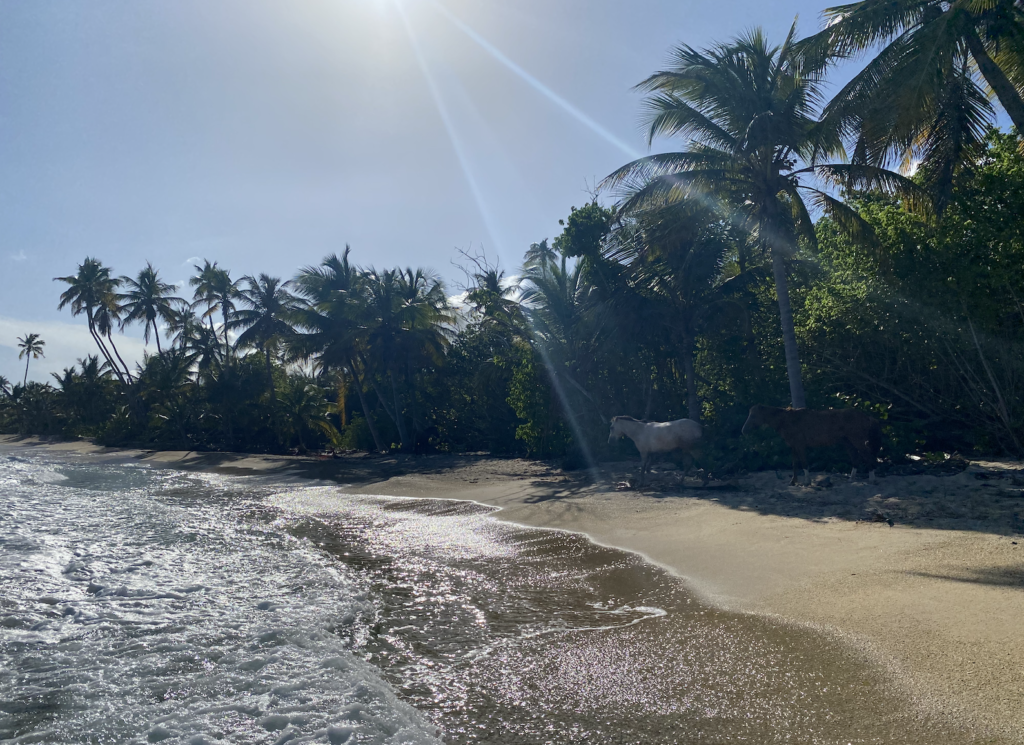
***
As heavenly as it appears now, Vieques has survived many waves of colonialism and disasters. Ruled for centuries as a Spanish colony, the Spanish-American War of 1898 turned Puerto Rico into an “unincorporated territory” of the United States. During WWII, the U.S. government expropriated two-thirds of the land on Vieques for part of the Roosevelt Roads Naval Station. Thousands of Viequenses were evicted from their homes.
After WWII, the U.S. Navy expanded its expropriation, using the western section for ammunition storage and the eastern section for bombing and war games (in 1998 alone, it dropped 23,000 bombs on Vieques). The navy also conducted tests of biological weapons on the island. As toxic chemicals permeated the soil, water, and air, the Vieques population suffered from significantly higher rates of cancer and other illnesses.
In 1961, the navy drafted a secret plan to evict the entire civilian population from Vieques. The plan was blocked after the Puerto Rican Governor intervened, and a vigorous local resistance movement emerged, first led by the island’s fishermen and gradually extended to a broader unity across ideological, political, religious, and geographic boundaries. Yet it was not until 2003 that the navy shut down its Roosevelt Roads naval base and withdrew from the V-island.
***
Vieques continues to suffer from the consequences of its past military grip, including unexploded ordnance and massive pollution. A big chunk of the northeastern island is closed off to this day, still under military cleaning.
Even when I was strolling in the wildlife refuge, there were frequent signs of explosive hazards along the trails. Not to mention the lingering impact of Hurricane Maria. Yet the islanders are grappling with these challenges through ingenious development projects, and ecotourism is one of the most important.
My first night here I spent kayaking on the Mosquito Bio Bay, famous for its bioluminescence produced by the dinoflagellate Pyrodinium bahamense, or “the whirling fire of the Bahamas.” The local guide, a passionate young man, proudly announced the bay’s Guinness World Record for the brightest bio bay in the world.
I took a tandem kayak by myself and broke the water with long paddle strokes. Moonlight spilled over a cloudless night, and for a moment I thought we were out of luck.
The guide stopped and told us to stir the water with our hands — and there it was, our hands glimmering blue, leaving a trail of flickering light with each movement, the magic of single-celled plankton. I dipped my paddle in and it glowed like a wand. The lights of life, small but divine.
But these lights don’t shine by themselves. The bay — stable with calm winds and low precipitation, surrounded by a mangrove forest, seagrass beds, coral reef, and neighboring lagoons — forms one of the most delicate ecosystems on earth.
We kayaked to the edge of the bay. Red mangroves take root there in the water and collect sediment, such that black mangroves settle on the newly formed land, then eventually give space to white mangroves. The “Walking Tree,” they say, honoring its vanguard spirit.
The guide surprised us with an astronomy laser pointer, aimed at stars and outlining the shape of constellations — Venus, Big Dipper, the tail of Scorpio… The Caribbean sky and the sea mirror one another, each deep and dark in their own unfathomable way.
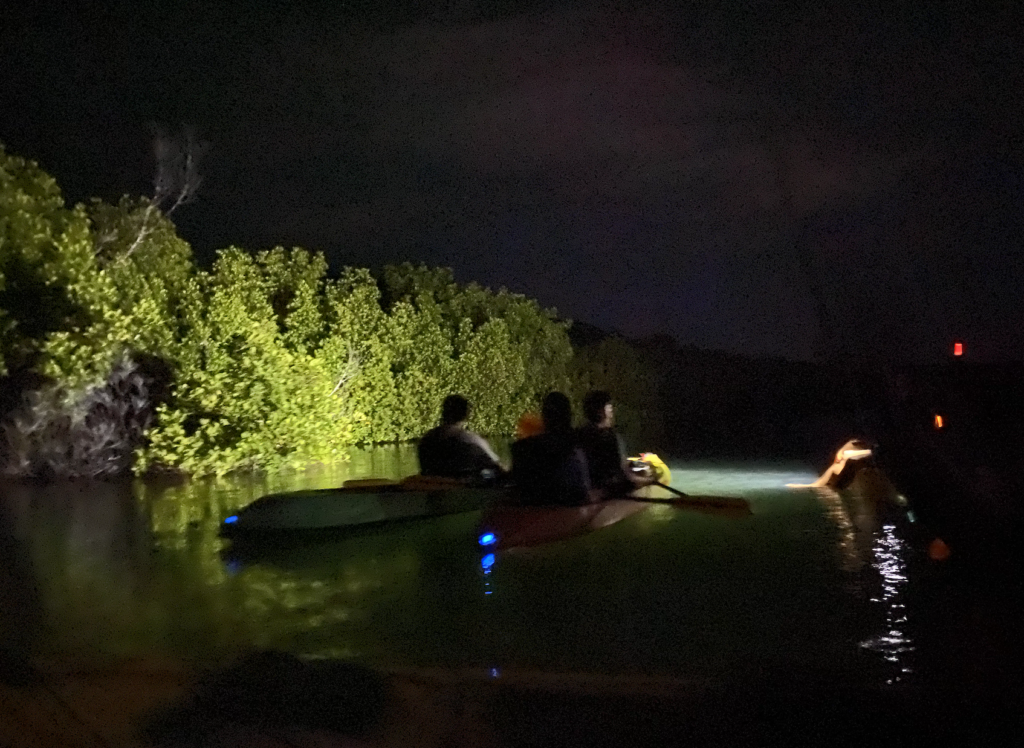
***
The next day, I ran into the young man with a long beard again and again. On my way to snorkeling, he walked out of the small grocery store in front of me. Then later in the day, I drove to Black Sand Beach but ended up on a small cliff overlooking a beach nearby. And suddenly there he was, right below me, bare-chested and rinsing his tank-top in seawater. I turned away, almost afraid that he would look up, as if I was a stalker.
And yet as I drove to Sun Bay Beach an hour later, he was walking on the road with his tattered backpack.
I wondered about him. Is he homeless? A wanderer? Is he a “good” person? Do people see him as often as I do?
I held on to these questions as I strolled by the sea at night under the red street nights — I grasped them so fast that I lost them, forgetting to ask the locals.
I never found out. And I never saw him again. But his image stayed with me, in one way or another, true or false, or somewhere in between.
***
“I thought it was dying, but it’s just taking its time to grow, to replenish itself.”
I lingered beneath the giant 300-year-old ceiba tree, touching its roots, feeling its warmth, all the while eavesdropping on the nearby local guide of a Chinese couple.
“The leaves were all falling, the branches naked. I was worried. But you see these white pouches? The old ceiba is healthy as ever. In Vieques, we learn from nature and take our time.”
“Take our time” — I find this phrase mesmerizing, as if time always belongs to us, we just have to become aware and take possession of it. It’s one way to live and think we have time, and another to say time has us. I consider both valid choices, and most of us do seem to alternate between the two, being intentionally oblivious to our contradiction.
And so I took my time on the last morning on the V-island. I made my last stop at the Sugar Mill ruins trail on the eastern side.
The path was narrow, overgrown with bushes and vines that scratched and entwined my bare legs. Tall trees stand on the side, lighthouses on a green sea that rolled toward mountains far away. Yet I couldn’t see any ruins throughout the trail, despite even squeezing through gaps and holes under the vines until deterred by their impassable web.
But the place itself reminded me of the Chinese legend of 世外桃源 (“Shi Wai Tao Yuan”), or literally the Otherworldly Land of Peach Blossoms. A fisherman stumbles upon a secret Utopian land and reports to the prefect, betraying its inhabitants. Yet when they searched for it again, the way was lost.
It was not until I returned to the trailhead that I realized I hiked on the wrong trail. The correct entrance was right in front of my car, with a big sign and the old red brick wall. How blind can one be!
But I have no complaints. The wrong path is the one that leads to the Shi Wai Tao Yuan, a land that lives in between lines on the traveler’s map. A land that can only be found once.
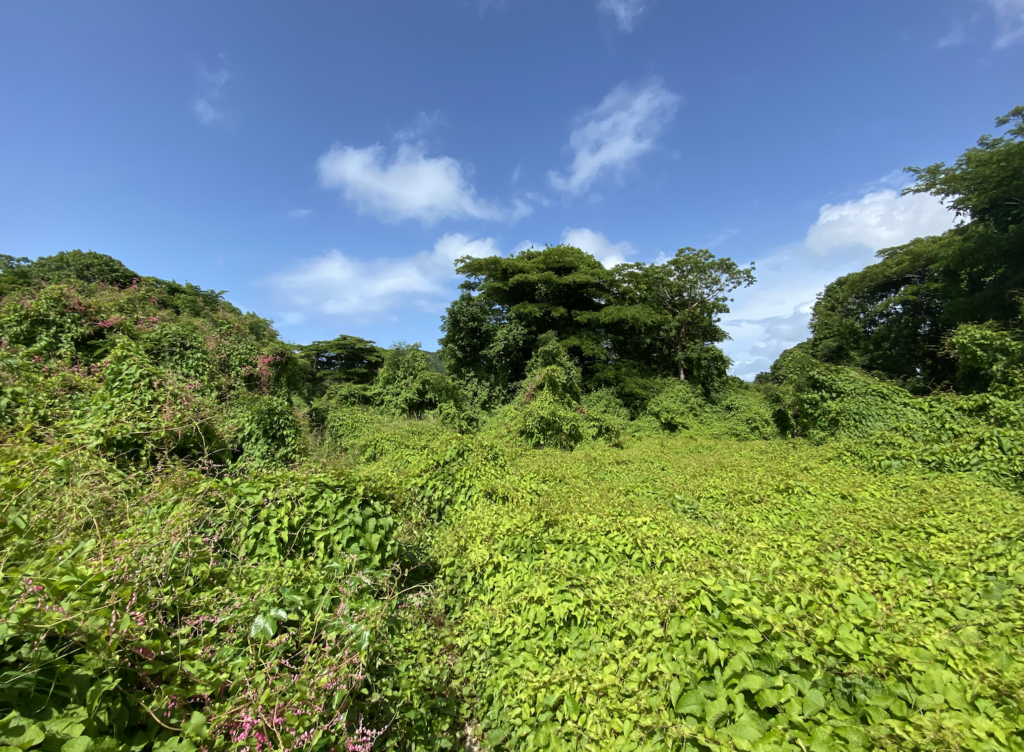
Day 7, 8/8, El Yunque & Ponce — Solo, soul, solus
People ask if I’m by myself. I usually tell them the truth — “Woo hoo, solo traveler!” — unless the question comes from a single man, most of them drunk or teasing.
This is my first solo trip from beginning to end. I try to travel widely, if not wildly, during the day and write at night. Writing gives me a sense of internal anchor no matter where I go.
I wonder if Sanmao, a Chinese writer known for her extensive travel writing around the way, felt the same way. When I was 10, I carried Story of the Sahara to school and declared to my parents that I had the heart of a wanderer (“浪子之心” — perhaps misinterpreting the Chinese phrase as a naive kid with big dreams).
Different from my past trips, this time I recognized the dual nature of solo traveling from the very first day. It reminds me of Levinas’ Time and the Other, the section on “Solitude and Hypostasis.” The solitary existent, alone in existence and without time, prior to any encounter with the Other, is said to have a minimal freedom of beginning. However, this beginning is not without limitations:
Its freedom is immediately limited by its responsibility. This is its great paradox: a free being is already no longer free (un être libre n’est déjà plus libre), because it is responsible for itself.
A solo traveler always stumbles upon this duality of being. On the one hand, she liberates herself from whatever restrains her — institutions, social norms, conventions, gossip, or men — and finally follows where her heart goes. She ventures into a rambunctious bar, a dark alley, a deep cave or remote woods, free from a second opinion or external judgment. She tries to open herself up in order to blend in with locals and nature, exposing her vulnerability in exchange for lessons and experience.
On the other hand, she needs to be responsible for her own life. She throws her cigarette into an unfinished drink to limit herself. She navigates the fine line between hospitality and harassment, wavering over whether to smile or stare back. She has the responsibility to constrain her freedom in order to survive for the freedom.
Don’t get me wrong — so far I have loved every moment of this solo trip, which turned out to be even more adventurous and fulfilling than I imagined. After all, Levinas wrote after his five-year incarceration as a prisoner of war during WWII. I write from a completely opposite, a delightful if not superficial, as well as privileged position — the privilege of being “alone.”
Here’s the contradiction of traveling alone: by freeing yourself from any fixed companions, you naturally turn outward and become more open and receptive to the world around you. Locals and places imbue feelings and connections into you as if by osmosis. Reflections and thoughts fill up your mind, sparkling ideas and inspirations. And most importantly, you learn to be with yourself, the most long-lasting relationship in life.
Yet there are many ways to interpret the action of “traveling.” A book that I read as a teenager and still admire deeply is 《一个人的村庄》(“A Village of One’s Own”?) by Liu Liang Cheng. He mostly writes about his own village in Xinjiang next to the Gurbantünggüt Desert, where the remotest point of land from any sea lies. He’s a solitary wanderer of his own hometown, yet his words, full of generosity and transparency, unveil a heart and a world much bigger than those of travelers in far places.
***
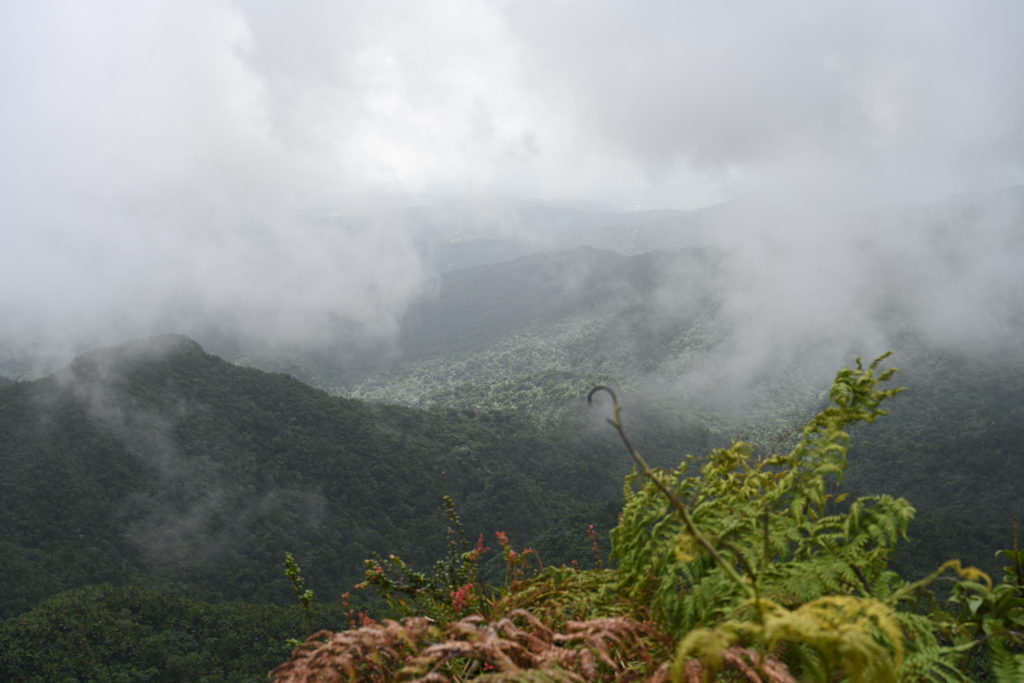
Today I hiked a trail at the famous El Yunque rainforest — which, to me, seemed lesser than the trails that I discover spontaneously. It was fun, though, playing with a small green anole on the peak — I was amazed when it changed from brown to green before jumping to the leaves!
Then I drove to Ponce, the city in the South where I will stay over for one night and return again two days later.
Day 8, 8/9, Inland PR: Adjuntas & Utuado — Songs of the dark mountains
Today is one of those days completely out of my plan, but it turned out to be one of the best days I have spent on the island.
The night before, I decided to take leave of the city and headed up to the mountains.
***
Part I: Coffee farm and mountain people in Adjuntas
“I apologize for the views. That’s all we have for now.”
Carmelo, a man my father’s age with a soft but stern voice, likes to make jokes about the mountains, which he loves so dearly. A former soldier in Germany for four years, he stayed for 20 more years and now has a son there. Having witnessed all the disturbances in Europe throughout the decades, he returned to his homeland.
Born and raised in Ponce, his family moved to the mountains when he was a teenager. Yet at that time he so disliked the idea of becoming a hick that he refused to go, hustling in the city to sustain himself instead. But now he’s come to the mountains by himself, building a house from raw woods and proud to become one of the mountain people.
An experienced and passionate coffee farmer, Carmelo took us on a tour of the farm he lives on and told us about the bittersweet history of coffee on the island. Introduced to Puerto Rico in 1736, coffee production expanded rapidly. The coffee sent to the Vatican used to come from this island, by the Cooperativa Cafeteros de Puerto Rico, once considered the best in the world.
The 19th century was a golden era until a hurricane in 1899 hit the island and devastated most of the crops. As Puerto Rico became a U.S. territory, the development resumed but the cost of production was also inflated, such that local coffee farms could no longer compete in a market dominated by cheaper Brazilian and Hawaiian beans. By 1950, the island had to import 90% (a number given by Carmelo) of the coffee consumed, a lot of them from Mexico.
In 2008, the Cooperativa Cafeteros de Puerto Rico was bought by Puerto Rico Coffee Roasters, owned by Coca-Cola, which mixed local beans with lower quality foreign beans. And the rest is history.
Carmelo pointed to a single peak in the distance, surrounded by hills and veiled by the Sahara dust.
“There’s a factory right there importing Mexican beans. I like to call it the ‘evil empire.’”
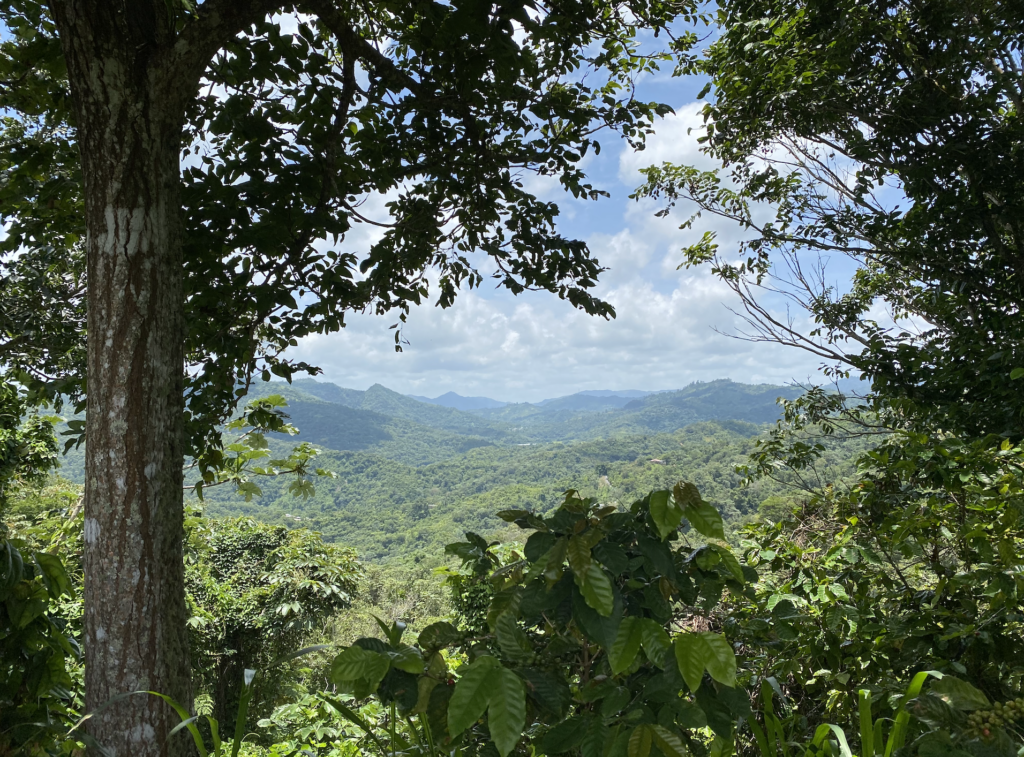
Foreign competition is not the only struggle. After Hurricane María hit the island on 2017, the farm lost electricity for one year and two months, and is still recovering from the losses. And today the farm depends on ecotourism like ours to sustain itself, all the while modernizing the machines to cut the cost.
After offering us various fruits and leaves to smell or taste on the way, Carmelo made us coffee with roasted beans from the farm. The fragrance drifted and then blended into the mountaintop breeze.
I’m not a coffee drinker, and I don’t know anything about coffee tasting. I savored the taste in my mouth carefully, mistaking acidity for sourness, all the while wondering about the future of this farm, and whether people will like its beans more than the cheaper ones.
But if there’s one thing I’ll remember from this tour, it’s the way coffee grows. If you cut down its stem, new stems will grow and bear fruit. The ones broken off by María now have new branches from the same old root. The plant revives itself.
Growing, growing, all for dear life.
***
Part II: Swim and sleep in the Utuado deep woods
I left the coffee farm and drove an hour east on the most meandering two-lane, and sometimes one-lane, mountain roads, finally arriving at a small sustainable farm where I would stay for the night.
Naldo, the young husband owner of the farm, appeared by the hand-drawn sign to welcome me with his four dogs. He has long black hair and a short beard, wearing a T-shirt stained with paints and small holes.
As we walked down the path to the communal space (also the kitchen) and, fifty feet down, their adobe home, Naldo told me he studied photography in Santa Barbara. Yet he has also put down the camera since he and his wife bought and refurbished the farm in 2016.
“You know how you always have to think about taking good pictures of everything, then you’re only seeing it behind the camera. I don’t like that anymore.”
But one day, he said, he might save enough money to buy a nice camera and take pictures casually. True, the aspiration to record everything through words and images is a trap, yet it’s also an innate human desire that is hard to give up — remember the cinematographer reeling his analog camera in front of a man-eating UFO in Jordan Peele’s new film, Nope. But the ability to let go is just as important as to capture — if life itself is to be prioritized.
My living space is another four-minute walk uphill from the kitchen, so private and shielded by trees that I walked around naked without the slightest shame. It’s an open-air wooden structure with a bed, a table, and two chairs on a deck, as well as a hammock between two pillars.
Behind the sleeping area is an open shower and compost toilet on a small staircase. My favorite kind of scenic bathroom without the claustrophobic walls.
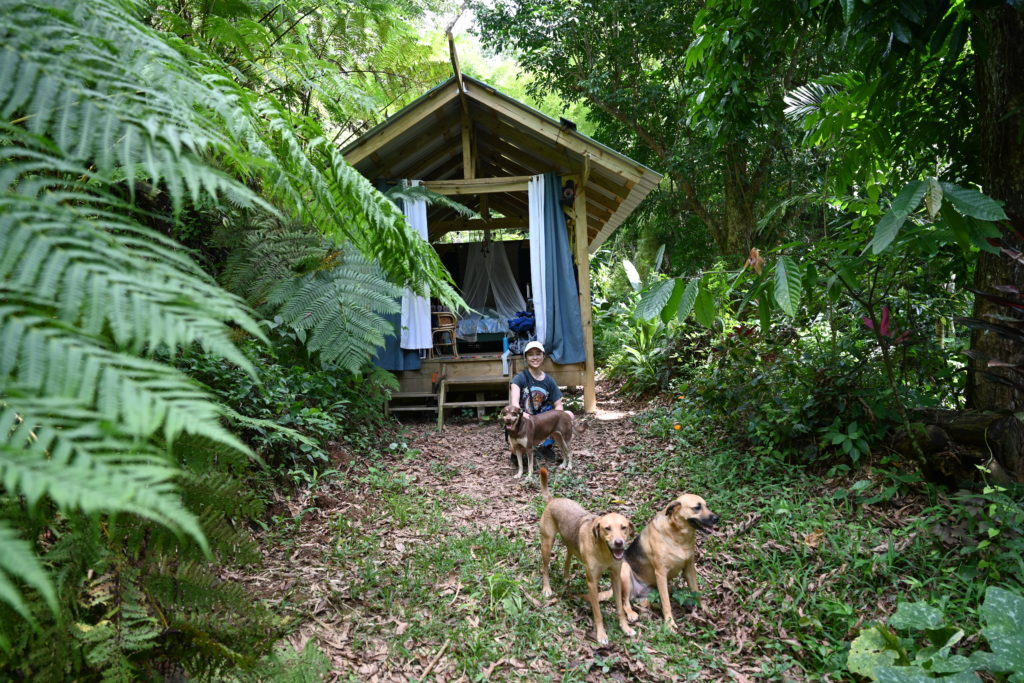
I put my backpack down and headed straight to a small off-grid trail leading down to the river. It was a steep and narrow pass thick with bushes and trees. My body constantly lurched into cobwebs with nail-sized dark spiders scurrying away.
Hundreds of steps later, I jumped down onto the edge of a river. The swimming hole under a waterfall was about 700 feet to the left, a distance made challenging by the slippery rocks, deep running water, lichen, and lush bushes on the side. Standing on a rock in the middle with no path forward, I thought about giving up but simply couldn’t.
I left my water bottle behind and crossed the river, climbing up the rocks on the edge and bushwhacking my way through. As careful as I tried to be, I ran into even bigger spiderwebs that wrapped my whole arm. A few eye-sized spiders crawled away and mocked me from a distance.
After much tripping and slipping, I arrived at the natural swimming hole surrounded by cliffs. A 30-feet waterfall pattered with a bomba-like rhythm. I took off my clothes and jumped into the water, skinny dipping for the first time in my life.
A stream of coolness seeped through my skin, into my blood. I haven’t felt so completely alone and connected with nature in a long while. I cherished every moment of it, knowing that there would be no way to capture this feeling. I let myself melt away, momentarily, not caring, or at least caring less.
I headed back right before sunset, got a little lost on the way up but eventually made it back to the kitchen. Naldo prepared dinner for me — pasta with eggplants, broccoli, and kale salad with cherry tomatoes all from the farm. One of the kitties jumped on the table and kept poking the salad, but it was too delicious for me to share.
***
Sunlight dissipated without my notice, and soon it was pitch dark. I wrote in the kitchen until having to use the bathroom. I was too scared to use the one nearby because the grave of an old woman watched it and the bamboo culms cracked in the wind.
With a headlight, I walked a few minutes back to the composite toilet behind my small open deck. A big toad led my way. The sharp shadows of tall grasses and vines twirled in the background with my steps.
It would be a lie to say I wasn’t afraid. In my past camping experiences, I had either been in a group or sleeping in a tent — an enclosed space. It was my first time sleeping in an open space alone in the mountains, completely exposing myself to nature throughout a dark night, away from people of all kinds. I left my solar-powered string lights on, drifted in and out of sleep, waiting for the moment it ran out of power.
And it did.
I woke up from the light turning off by itself. It was just past midnight. Yet as soon as I opened my eyes I was surprised to see that the forest wasn’t pitch dark at all. Moonlight was sharp and bright, delineating the shape of each moving tree and cloud. All the fireflies gathered around my net, carrying me away to a lulling Neverland.
And all the sounds and dances of nature — a myriad of birds, cicadas, and coquis chirping and croaking and rattling unseen yet within my arm’s reach. Nuts fell on the tin roof, along with a sudden spatter of rain. A palm-sized lizard rests on the top of my mosquito net. Cockroaches perched and flew. Branches hustled in the wind. The mountains came alive at night, their vast spirits flowing through a thousand smaller lives.
I always find that courage and trust go hand in hand. Trusting people, trusting nature, trusting yourself. One who trusts all the time would not survive, yet one who never trusts lives in a bubble made of fear. It’s always a fine balance to tread on, sometimes leading you to waltz on the edge of a cliff.
This night I chose to trust. I gave myself to nature, letting creatures of different forms come near me, and I felt their breath upon my skin. So close to heart, so close to home.
***
In the morning something stirred my bed. I opened my eyes, preparing myself for a foot-long lizard staring into my soul. But no — it was only the kitty, who ran here all the way from the kitchen to greet me. It slept by my legs, trusting me.
I felt some prickling on my arm and saw some cuts from the hike yesterday — threadlike scars around my elbow. Then I saw scars on the kitty’s back. And the plants around us all stood with broken leaves and blackened stems and trailing vines. I realized that I had never seen nature in its “perfect” form. All beings live with scars of some kind, and so do the land, the people, the country. Despite this, we open ourselves up and connect.
May we always live and grow and trust as stronger beings, I pray to the mountains.
“And I said to the man who stood at the gate of the year,
‘Give me a light that I may tread safely into the unknown.’
And he replied, ‘Go out into the darkness and put your hand into the hand of God. That shall be to you better than light and safer than a known way.’”
— Minnie Louise Haskins
Day 9, 8/10, Ponce & Rincón — An open door to la música puertorriqueña
I drove back to Ponce, La Perla del Sur (“The Pearl of the South”), known for its historical and cultural sites. But most of the museums, including the famous Museo de Arte de Ponce, were either temporarily closed or not open for the day. Few people walked under the scorching Caribbean sun, and the white marble fountain of Plaza Las Delicias stood lonely in the center of everything, if anything.
I took the detour to drive back to Ponce to visit Museo de la Música Puertorriqueña, the only museum listed as open for the day. Yet when I arrived it was closed for noon break.
I wandered around the city in excessive heat, stumbled into another small museum that was only partially open. The main hall was closed for repairs of the earthquake damages, but the host warmly received me and a few other tourists.
Without much display to show, he pointed at the buildings nearby — tropical-colored houses and mansions built in the unique Ponce Creole architectural style, with broad columned porches and balconies made of wood, a blend of Spanish Creole and neoclassical architecture. Another two houses, he added, were respectively Art Deco and Neoclassical, the two other dominant styles in Ponce.
The brief tour was over in ten minutes, and I strolled again, now beholding the porch of each house, a game to differentiate the styles. Graffiti of local figures popped up here and there. The city was home to many artists and poets, and I could suddenly sense their lingering presence in a city that seemed to be hibernating in a hot summer.
Eventually I ended up at the front step of the music museum, closed still even after its lunch hours. I sat on the sidewalk, right outside of the locked gate, wondering what to do next.
A man with a gray goatee (perhaps because no one in my family grew a beard, I became particularly sensitive to that) and a ponytail hurried out all of a sudden. He said his colleague, the host at the previous museum, saw me sitting outside under the sun and called him to open up. But the man with a goatee, who later introduced himself as Hannibal (“But not like that!”), explained that he couldn’t do a tour today because of some research.
Slightly let down, I walked around and used google translate to read the Spanish expositions. All the instruments lay on the shelves silently, with signs that said: “Do Not Touch.”
Just as I shouted thank you to his half-closed office and was about to leave, Hannibal rushed out and asked if I had any questions. He noted that Puerto Rican music shares a wide range of common vocabularies and influences with African and South American indigenous music. Puerto Rican Bomba, the first native music of Puerto Rico, was created in the sugar plantations by the African slaves brought by the Spaniards during the 1600s. Slaves from different African tribes communicated through this music, using European barrels to create native drums.
In terms of the South American presence, there are a variety of flutes, ocarinas, drums, musical bows and South American marimbas, harps, mayohuacán, the fotuto or indigenous snail, as well as rattles and maracas. This ancestral heritage still resonates in the streets of Puerto Rico every time scissor grinders announce their presence with the traditional pan flute, or the celebration of the Trulla de Inocentes with fotuto on December 28.
I asked what in his opinion made Puerto Rican music unique despite all these shared elements with other continents. He laughed, saying it was a research question. “I think it’s the Puerto Rican interpretation of music that made it unique. Just like the way it is a happy country.”
Then he stroked his goatee with seriousness and wrote me a list of music to check out online: from bomba to typical Puerto Rican music such as El Seis Chorreao, Aguinaldo, and Danza, to popular music such as boleros from the 50s and 60s.
A few other tourists came to the gate as I left, and he told them the museum could not be opened for the day. Pretending to close the door, he winked and said he opened it for me only because his colleague told him I sat on the sidewalk waiting.
I drove to my next stop, Rincón, listening to the Puerto Rican music Hannibal and his little museum introduced me to. I thought of his words, and realized I have perhaps asked a naive question which he nonetheless answered wisely.
The word “unique” is overused and often a futile attempt to draw clear boundaries, while cultures and arts always transcend geographical borders and academic definitions. It is, indeed, the interpretation of an art form that makes it personal and one of a kind.
I listened to a Seis Chorreao, the backbone of Jíbaro (country folk) that came from the mountains of Puerto Rico where humble coffee farmers celebrated their harvest with music and dance. It incorporated influences from Spain in the late 17th century, Arabic culture, as well as the legacy of the Taíno.
The lively notes of cuatro and guiro lifted my heart as I headed to the great surfing city on the west coast.
Day 10, 8/11, Aguadilla & Arecibo — The way here
The waves were mellow on Surfer’s Beach in Aguadilla at 7 am. Chris, my young instructor, struck up conversations with other surfers, who he might or might not know. An old lady with white hair paddled toward the breaking waves like a warrior. A couple rode the waves like clouds one after the other.
Chris grew up in New York, the Long Beach area. He traveled to Puerto Rico frequently since he was 13, and then moved here after high school at 17. When I said I was going back to New York tomorrow, he said that’s a tough place to go back to. I asked him what brought him here, then a big wave came and interrupted us. Maybe that was the answer.
Throughout my journey I have encountered many people who moved here from the mainland U.S., especially New York City. And I like to imagine how they found their ways here, a Caribbean island so different in many ways from one of the busiest cities in the world. Some of them told me they came with family. Others, like Chris, came by themselves for the island lifestyle.
A young mother whom I shared a small table with in a Mexican restaurant observed that a lot of mainlanders are moving to the island during the last five years, especially people looking for individual and corporate tax breaks. But the influx of affluent new settlers has pushed up home prices and displaced local residents who couldn’t afford to live in their hometowns. And Rincón, the northwestern seaside town famous for surfing and sunsets, has become one of the hot spots.
I looked at the beach before heading to my last stop, Arecibo. Places change, people change, the sea rises, and sometimes it’s hard to define “forward” and “backward.” The past threatens to engulf us, and we run and run and run.
***
The first settlers of Puerto Rico, according to archeological studies, were the Ortoiroid people, an Archaic Period culture of Amerindian hunters and fishermen. Then came the Igneri and the Arcaicos. Between the 7th and 11th centuries, the Taíno culture became dominant on the island — until Christopher Columbus arrived in 1493. Organized in small clans and villages, the Taínos were governed by the chief Agüeybaná and called the island Borikén — “Land of the Valiant and Noble Lord.”
In Arecibo, I visited the Cueva del Indio, a cave surrounded by sharp cliffs and engraved with pre-Columbian indigenous petroglyphs on its inner walls.
To enter the cave, you have to climb and slip yourself through a narrow crevice five feet above the ground. Then you prompt yourself in between two slippery walls, with a deep gap in between that you might fall through. I almost slipped but then saved myself by grabbing hold of a rock with my toes. Small bats lined the top of the cave, occasionally flying around but never too close to the visitors.
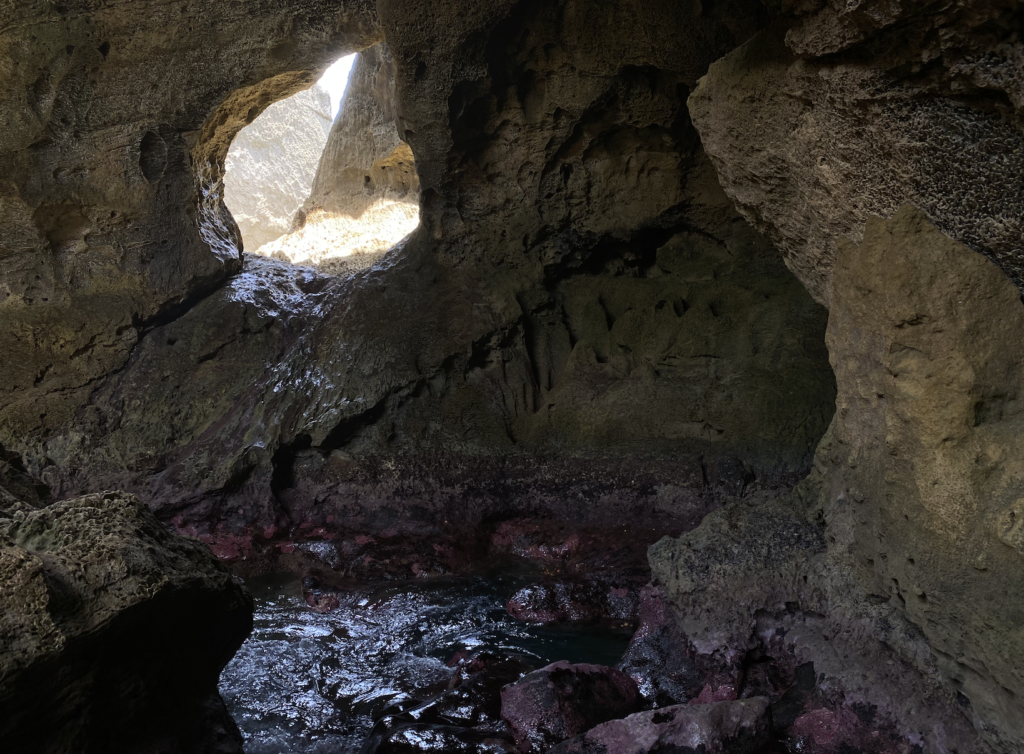
One of the rooms open to sunlight, where Taíno Indians performed their sacred rituals and religious ceremonies, is filled with old petroglyphs. Symbols of petroglyphs tend to fall into three categories: anthropomorphic (human-like), zoomorphic (animal-like), or highly abstract. Most of the ones I saw resembled human faces or figures.
I imagined how their ceremonies took place here, encompassed by sharp rocks and the sound of breaking waves. And most importantly, how they found their way here, without signs and roads, following the coastline and sun.
Then in other rooms you see carvings from our modern times, with heart-shaped drawings and names. In 2016, a businessman bought the land and tries to privatize the site, now charging $10 for access through the safest route to the view. The petroglyphs and caves remained, but the interpretation lost, it seems.
***
But who dictates what is lost, and what remains?
For centuries, the Taínos were said to be extinct. But many modern, self-identifying Taínos — as supported by recent DNA testing results — believed that their “extinction” was imposed by the census, which simply stopped counting them, but their identity persisted.
“A people can be made to disappear on paper,” said Jorge Baracutei Estevez, the leader of a Taíno community group in New York. “A narrative created by the conquerors and perpetuated by every subsequent researcher.”
Remember, what we name is few, and most live without names. And may those without names live on beyond those of us with names, I pray to the sea.
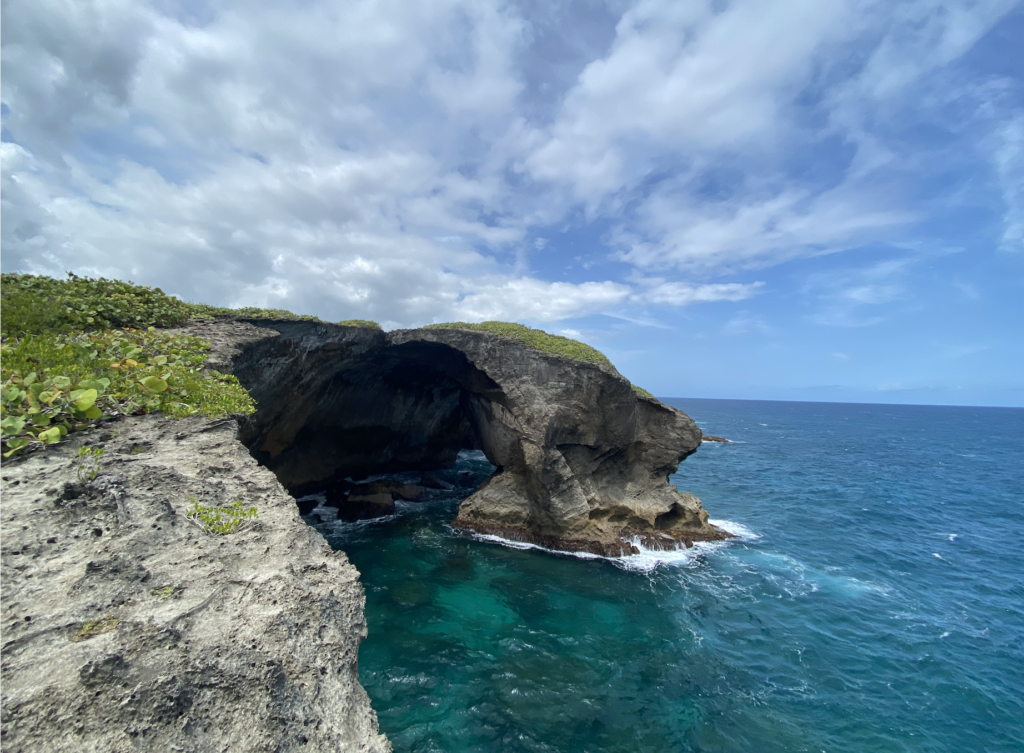
Day 11, 8/12, San Juan & New York City — The way home
It’s time to go home.
People here ask me where I’m from. “New York,” I blurt out.
But then I add: “But I’m originally from China.”
And then more: “But I went to California for college.”
Should I say I went to Pennsylvania for high school? Not necessary, I think to myself.
***
Of course people have always asked me where I’m from, and I found my first answer changing throughout the years. Each place I lived in transforms me greatly, and all of them make up who I am today.
But not just the places I lived in, but also those I visited, however briefly. Despite the impossibility of fully capturing and interpreting, each traveling experience bleeds into my blood and soul.
I am more than grateful for the opportunities to see the world from different places, to meet people living all kinds of lives, and to understand myself better in relation to the world.
And I find myself missing New York a little now.
Thank you for the journey, thank you.
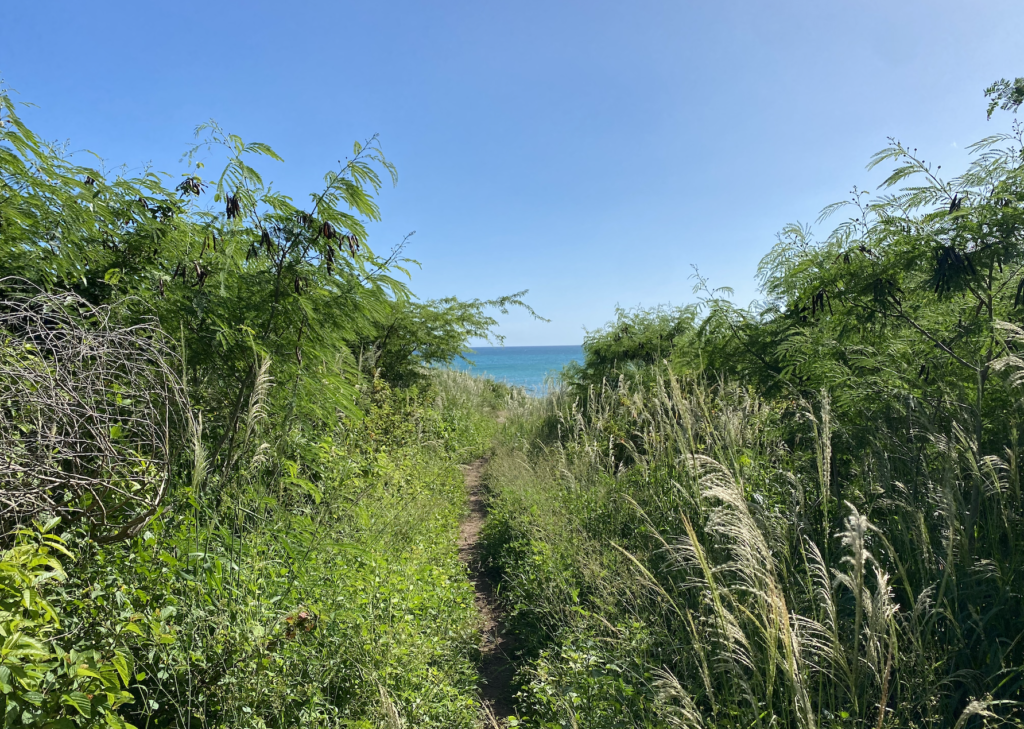
Work Cited
Abe, Kōbō. The Woman in the Dunes. Translated by Ernest Dale Saunders, Knopf, 1964.
Ayala, Israel Meléndez. “The Coffee History of Puerto Rico — Whetstone Magazine.” Whetstone Magazine, 3 August 2021, https://www.whetstonemagazine.com/journal/the-coffee-history-of-puerto-rico. Accessed 11 August 2022.
Calvino, Italo. Las ciudades invisibles. Minotauro, 1983.
Estevez, Jorge Baracutei. “On Indigenous Peoples’ Day, meet the survivors of a ‘paper genocide.’” National Geographic, 14 October 2019, https://www.nationalgeographic.com/history/article/meet-survivors-taino-tribe-paper-genocide. Accessed 13 August 2022.
Mahadane, Roopak. “The Philosophy Of Flow — Taoism. “That which offers no resistance… | by Roopak Mahadane | Nova Semita.” Medium, 2019, https://medium.com/novasemita/the-philosophy-of-flow-taoism-f176f1de2999. Accessed 8 August 2022.
Stoneking, Cain. “The Decline of the Tainos, 1492-1542: A Re-Vision.” Digital Commons @ WOU, 2009, https://digitalcommons.wou.edu/cgi/viewcontent.cgi?article=1222&context=his. Accessed 13 August 2022.
“Tax Breaks Are Driving a Rush to Buy Property in Puerto Rico.” The New York Times, 16 March 2022, https://www.nytimes.com/2022/01/31/us/puerto-rico-gentrification.html. Accessed 13 August 2022.
Wittner, Lawrence. “Breaking the Grip of Militarism: The Story of Vieques.” History News Network, 28 April 2019, https://historynewsnetwork.org/article/171839. Accessed 8 August 2022.
